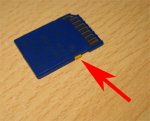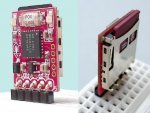demonicpicaxeguy
Senior Member
it's been a long time going at it with different cards from different manufacturers, different voltage regulators , and various different circuits trying to get a reliable and repeatable read and write operation out of any of these cards
the sd specification is lousy at describing the 1 bit spi protocol in any real detail and the mmc specifications aren't much better
the vast majority of the cards i have tried, do not follow the 1 bit spi mode in any reliable way or at all to the specifications
now that i have officially given up on the whole sd card and mmc card idea i'm looking at alternatives that is much easier and simpler to interface to and i've got this in mind since i've had some experience with similar devices in the past:
The K9F8G08U0M-P by samsung is a 48 pin 8gbit(1gbyte) flash chip
the chip itself actaully only uses about 14 pins for operation and is built in a similar fashion to the old style parallel eprom memmory only extended a bit to accomadate the larger capacity
i'm looking into mounting these onto a pcb with a 3.3 regulator and a level shifter and if anyone is interested i'm willing to stick a reasonable price on them
anyone got any ideas ,thoughts ,coments and criticisms of the idea?
the sd specification is lousy at describing the 1 bit spi protocol in any real detail and the mmc specifications aren't much better
the vast majority of the cards i have tried, do not follow the 1 bit spi mode in any reliable way or at all to the specifications
now that i have officially given up on the whole sd card and mmc card idea i'm looking at alternatives that is much easier and simpler to interface to and i've got this in mind since i've had some experience with similar devices in the past:
The K9F8G08U0M-P by samsung is a 48 pin 8gbit(1gbyte) flash chip
the chip itself actaully only uses about 14 pins for operation and is built in a similar fashion to the old style parallel eprom memmory only extended a bit to accomadate the larger capacity
i'm looking into mounting these onto a pcb with a 3.3 regulator and a level shifter and if anyone is interested i'm willing to stick a reasonable price on them
anyone got any ideas ,thoughts ,coments and criticisms of the idea?
Last edited:



